

Chem. J. Chinese Universities ›› 2021, Vol. 42 ›› Issue (2): 412.doi: 10.7503/cjcu20200673
• Review • Previous Articles Next Articles
LIN Shenghuang1,4( ), FU Nianqing2(
), FU Nianqing2( ), BAO Qiaoliang3(
), BAO Qiaoliang3( )
)
Received:2020-09-10
Online:2021-02-10
Published:2020-12-28
Contact:
LIN Shenghuang,FU Nianqing,BAO Qiaoliang
E-mail:linshenghuang@sslab.org.cn;msnqfu@scut.edu.cn;Qiaoliang.Bao@gmail.com
Supported by:CLC Number:
TrendMD:
LIN Shenghuang, FU Nianqing, BAO Qiaoliang. Recent Advances in the Applications of Elemental Two-dimensional Materials and Their Derivatives Serving as Transport Layers in Solar Cells[J]. Chem. J. Chinese Universities, 2021, 42(2): 412.
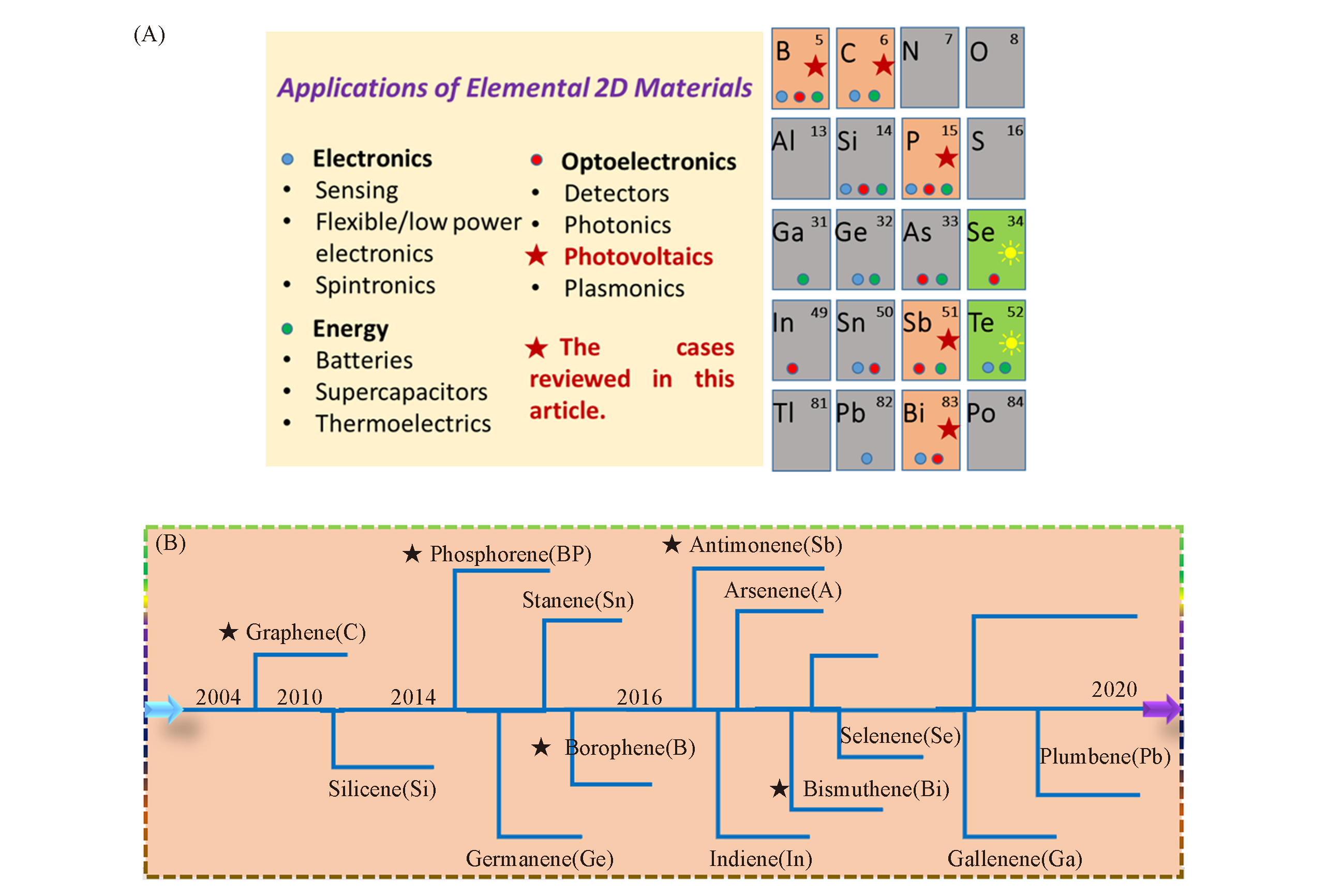
Fig.2 Overview of elemental 2D materials explored through experimental or theoretical approaches(A) and a roadmap of several recent elemental 2D materials being investigated in experiments or theory(B)The pentagram star in (A) reveals the cases we studied in this work.
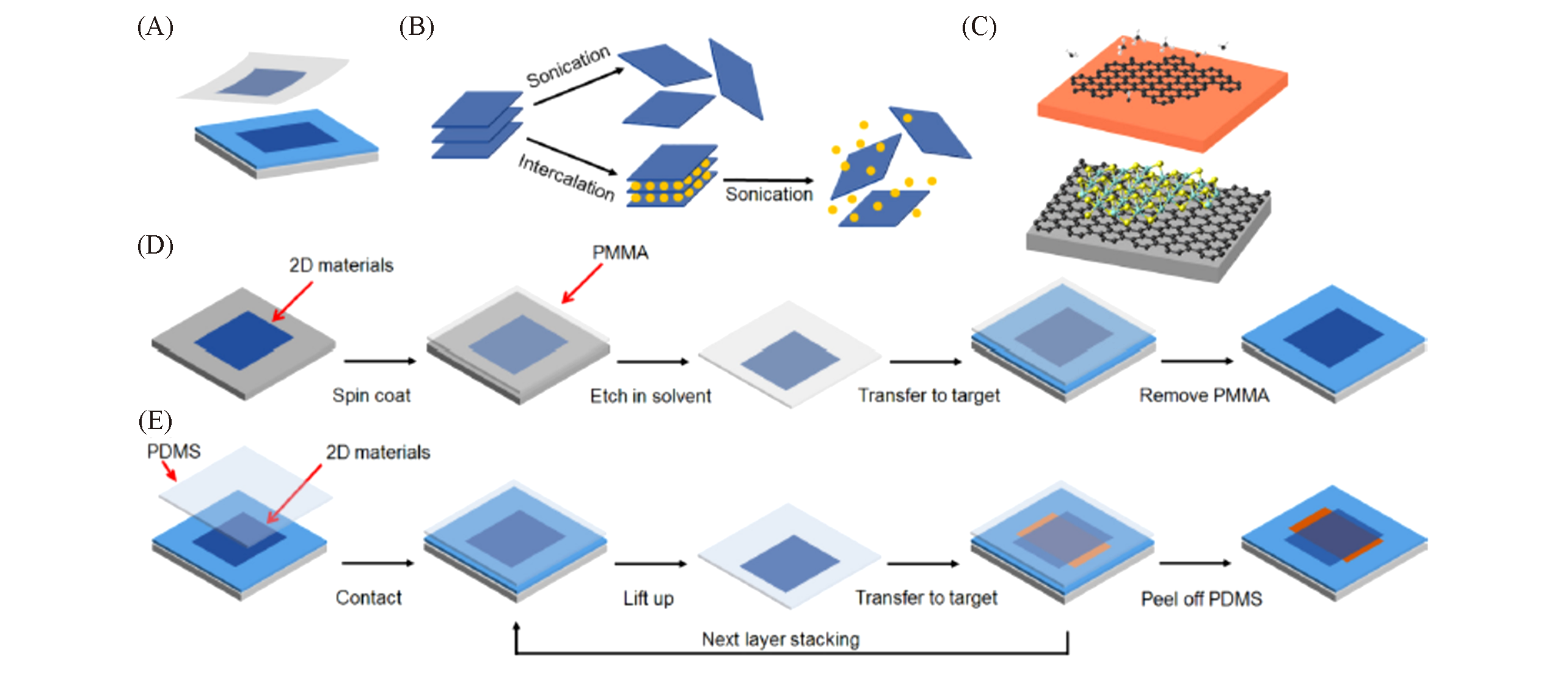
Fig.3 Mechanical exfoliation(A), liquid?phase exfoliation(B) and CVD(C) approaches for the synthesis of 2D materials[48]Copyright 2017, American Institute of Physics.
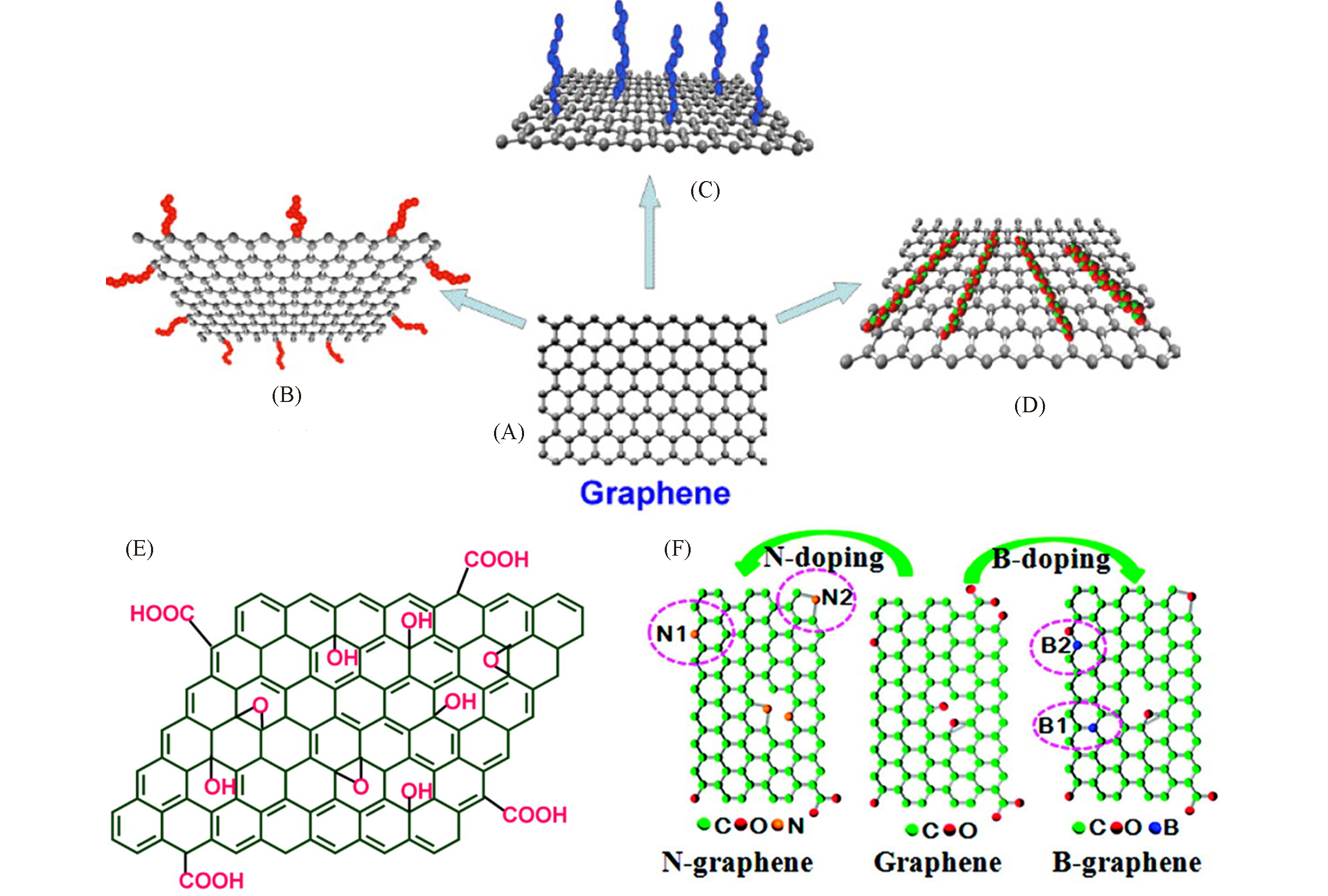
Fig.4 Schematic illustration of functionalized graphene by various strategies[99](A) Pristine grapheme; (B) edge-functionalization; (C) basal-plane-functionalization; (D) noncovalent adsorption on the basal plane; (E) chemical structure of graphene oxide(GO)[99]. Copyright 2013, American Chemical Society. (F) Schematic structure of N- and B-doped graphene[100]. Copyright 2011, American Chemical Society.
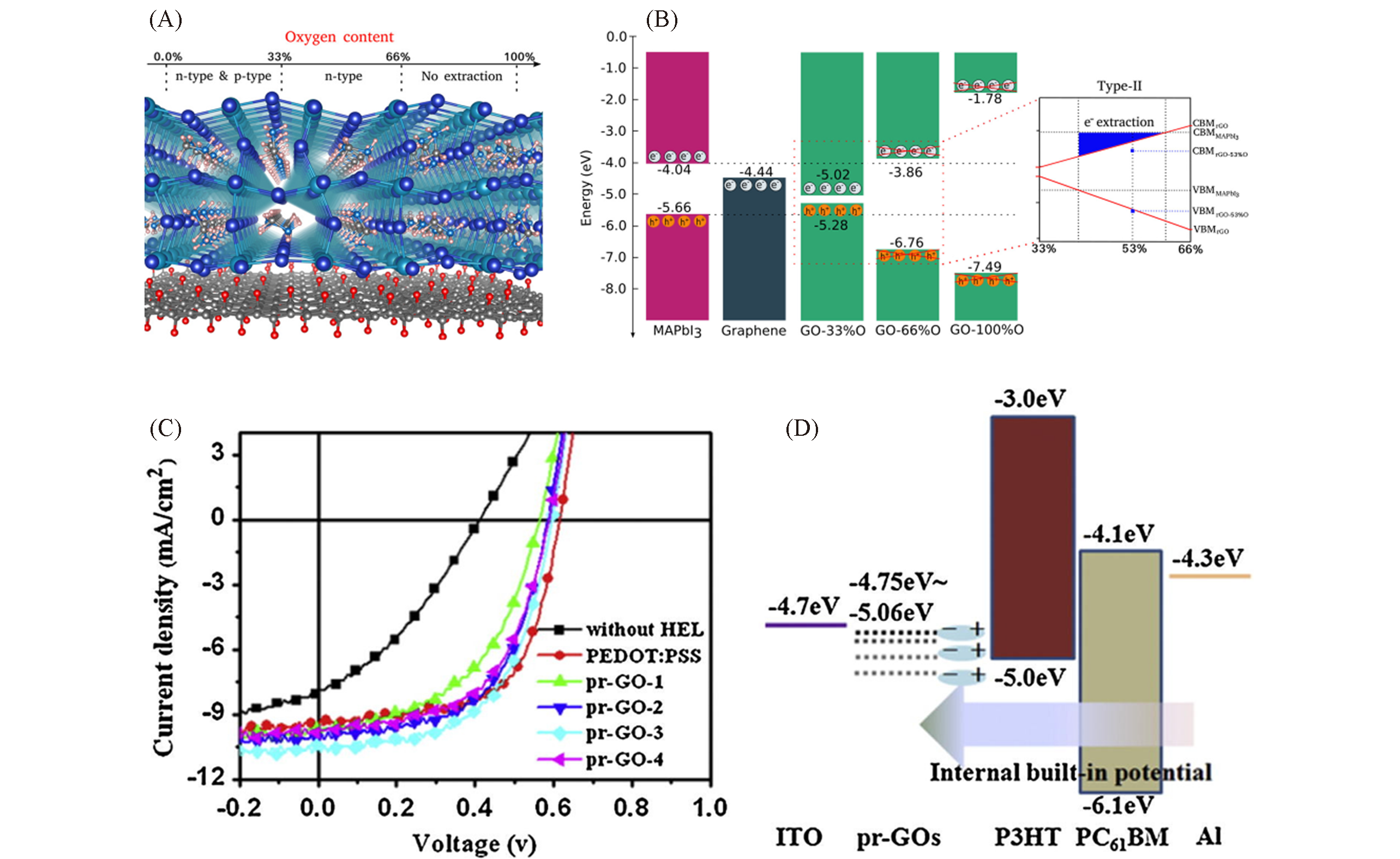
Fig.5 Theoritical and experimental results of tuning oxygen concentration in GO transport layers for enhancing the PCE of OPV devices(A) Schematical representation of the conduction-type of the GO/CH3NH3PbI3 with the oxidation level of GO; (B) energy-level alignment within the GO/CH3NH3PbI3 heterojunctions. The red cross-lines in rGO-66%O and GO-100%O indicate a forbidden charge transfer(The inset highlights the interpolated band alignment between rGO-33%O and rGO-66%O, where the blue-shaded area corresponds to a type II heterojunction)[117]. Copyright 2018, The Royal Society of Chemistry. (C) J?V curve of devices based on ITO/HEL/P3HT:PC61BM/LiF/Al structure, with HEL of PEDOT:PSS, graphene oxide with varied oxidation(pr-GO) and HEL-free; (D) energy level diagram of device[118]. Copyright 2014, Elsevier.
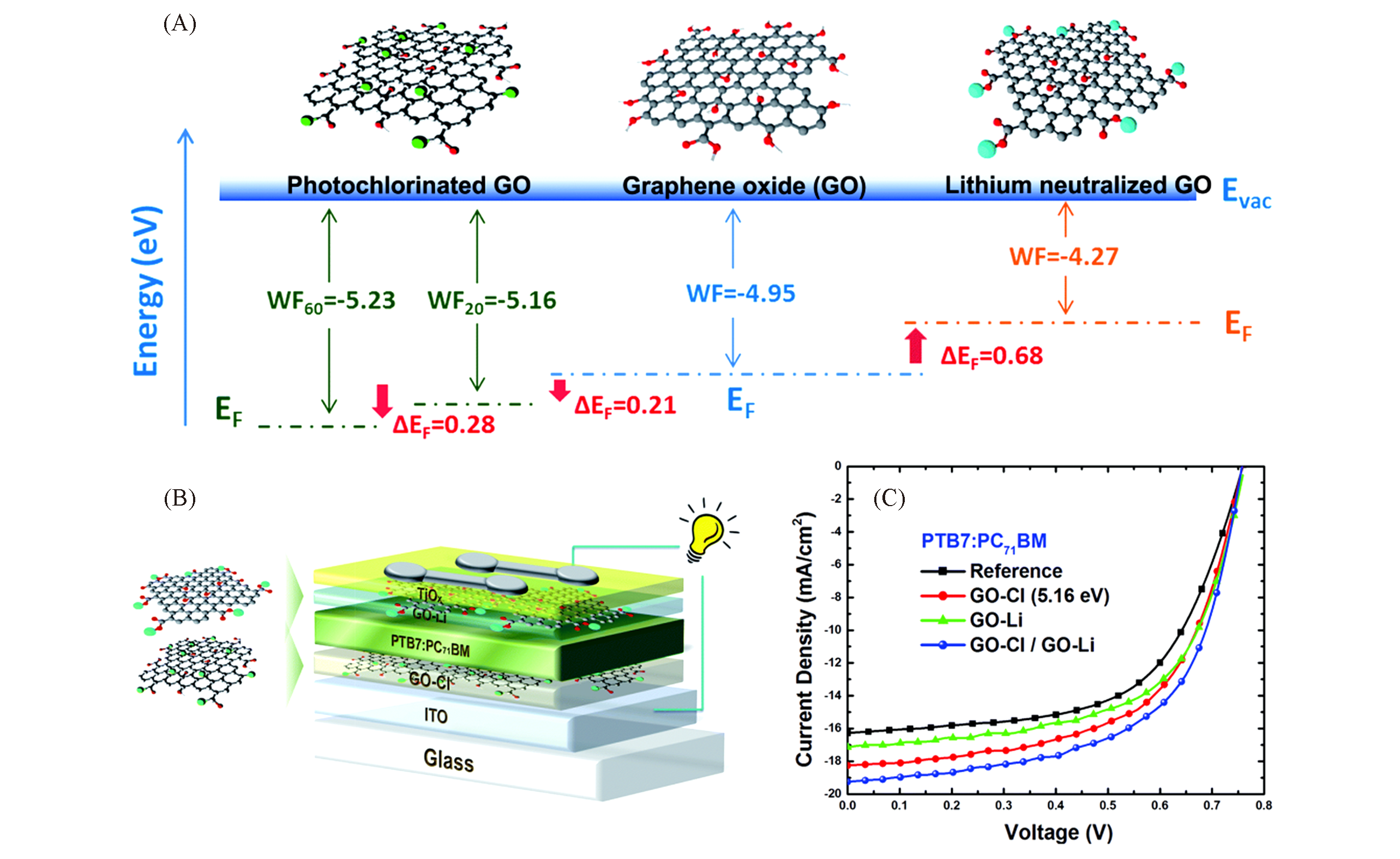
Fig.6 Tuning the energy band of GO by chemical dopping and its performance on organic solar cells[130](A) Energy diagram showing the Fermi level of GO(middle) and its shifting after the functionalization with Cl(left) and Li(right); (B) schematic illustration of the BHJ OPV device with GO-Cl as the HTL and GO-Li/TiOx as the ETL; (C) J?V characteristics of PTB7:PC71BM-based photovoltaic devices. Copyright 2016, Royal Society of Chemistry.
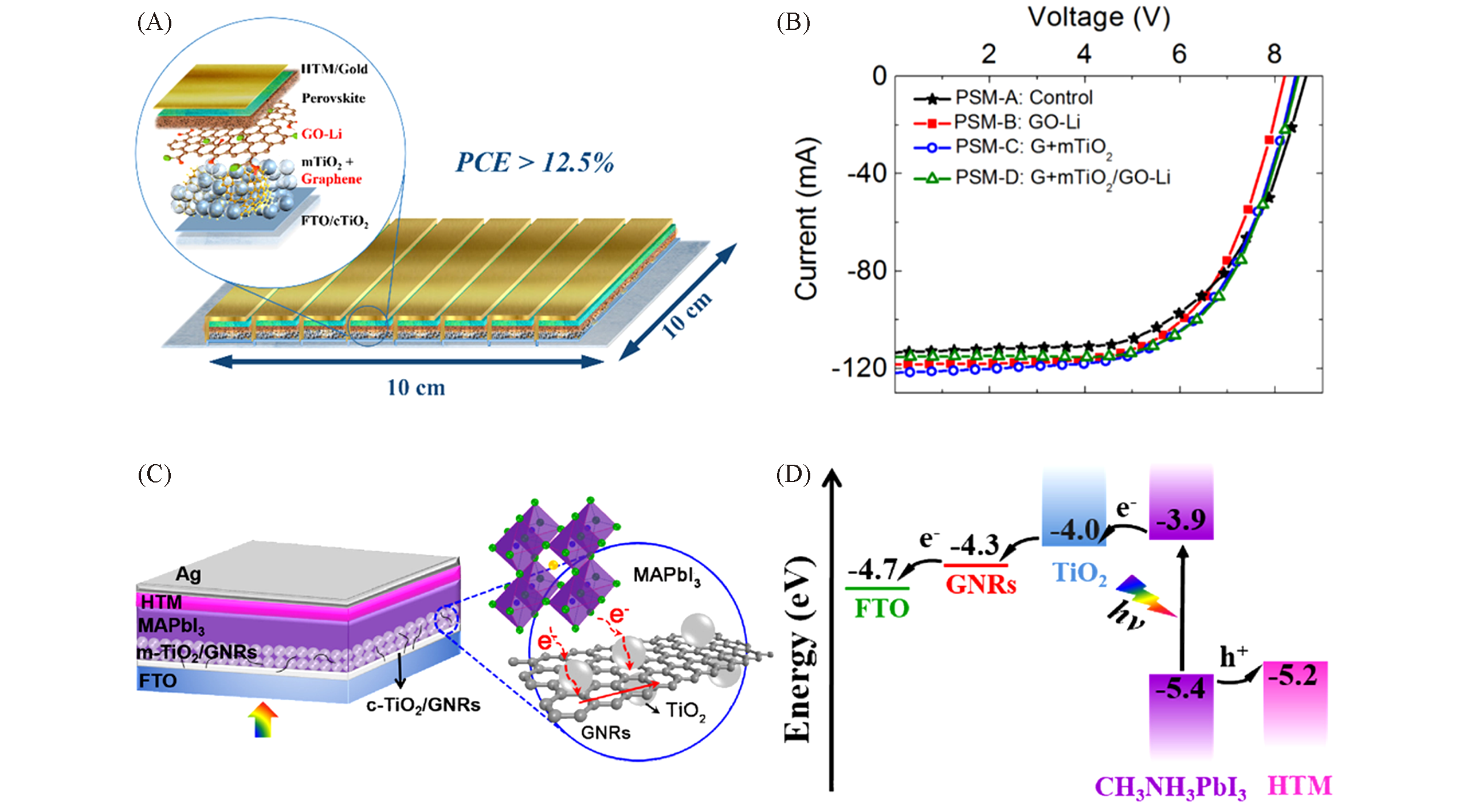
Fig.7 Chemical doped GO and its performance in perovskite solar cells(A) Schematic representation of PSCs-module structure with graphene and GO-Li inclusion; (B) the current-voltage(I?V) characteristics of tested modules[143]. Copyright 2017, American Chemical Society. (C) Schematic illustration of device architecture; (D) energy level diagram of m-PSC with GNRs incorporated into TiO2 ETL[145]. Copyright 2018, Elsevier.
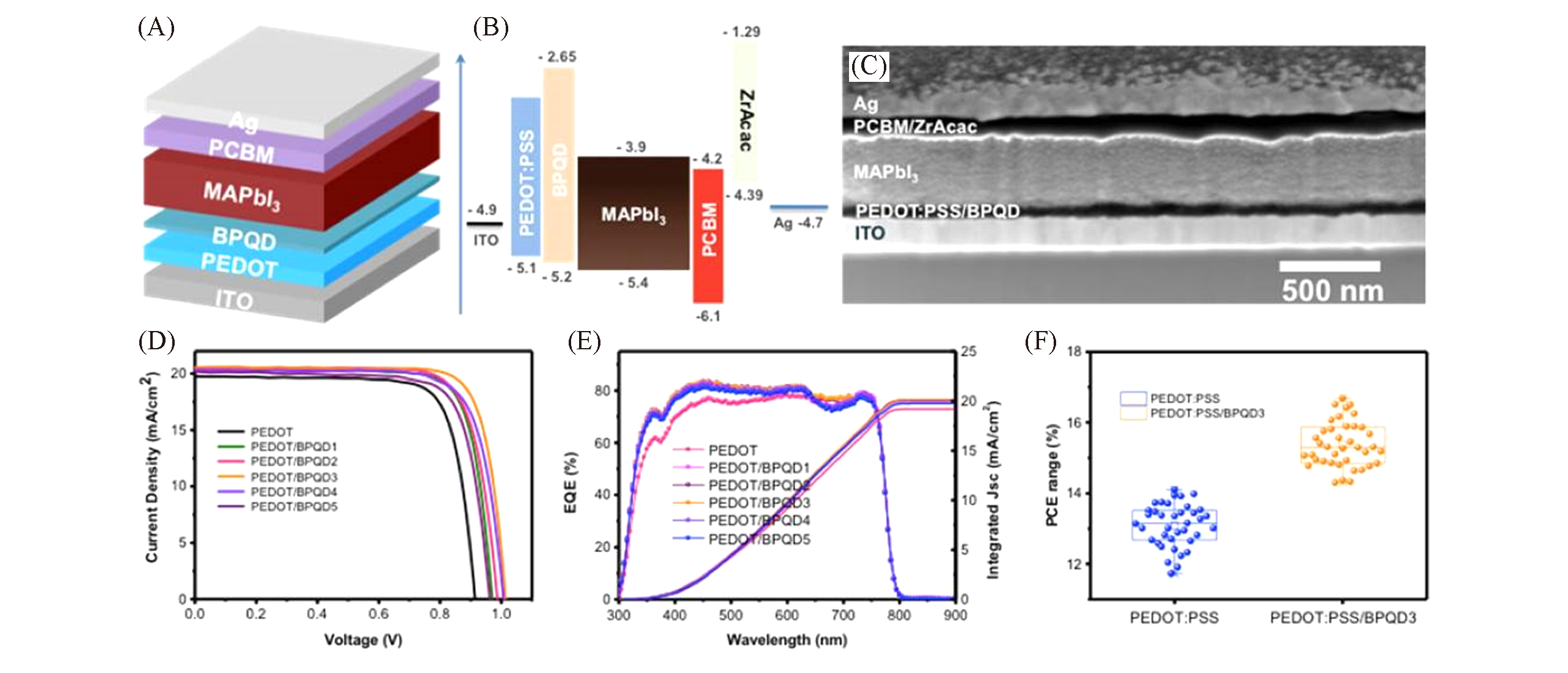
Fig.8 BPQD as hole transport material in perovskite solar cells[158](A) Configuration of the p-i-n planar PSCs; (B) energy level diagram of each functional layer; (C) cross-section SEM of an optimal device; (D) J?V curves of PSCs in a forward scan, measured under 100 mW/cm2 illumination; (E) EQE spectra of the optimal PSCs with different times(0—5) of BPQDs coating as interlayers; (F) device performance statistics for the PSCs with BPQD and without BPQD as interlayers. Copyright 2017, American Chemical Society.
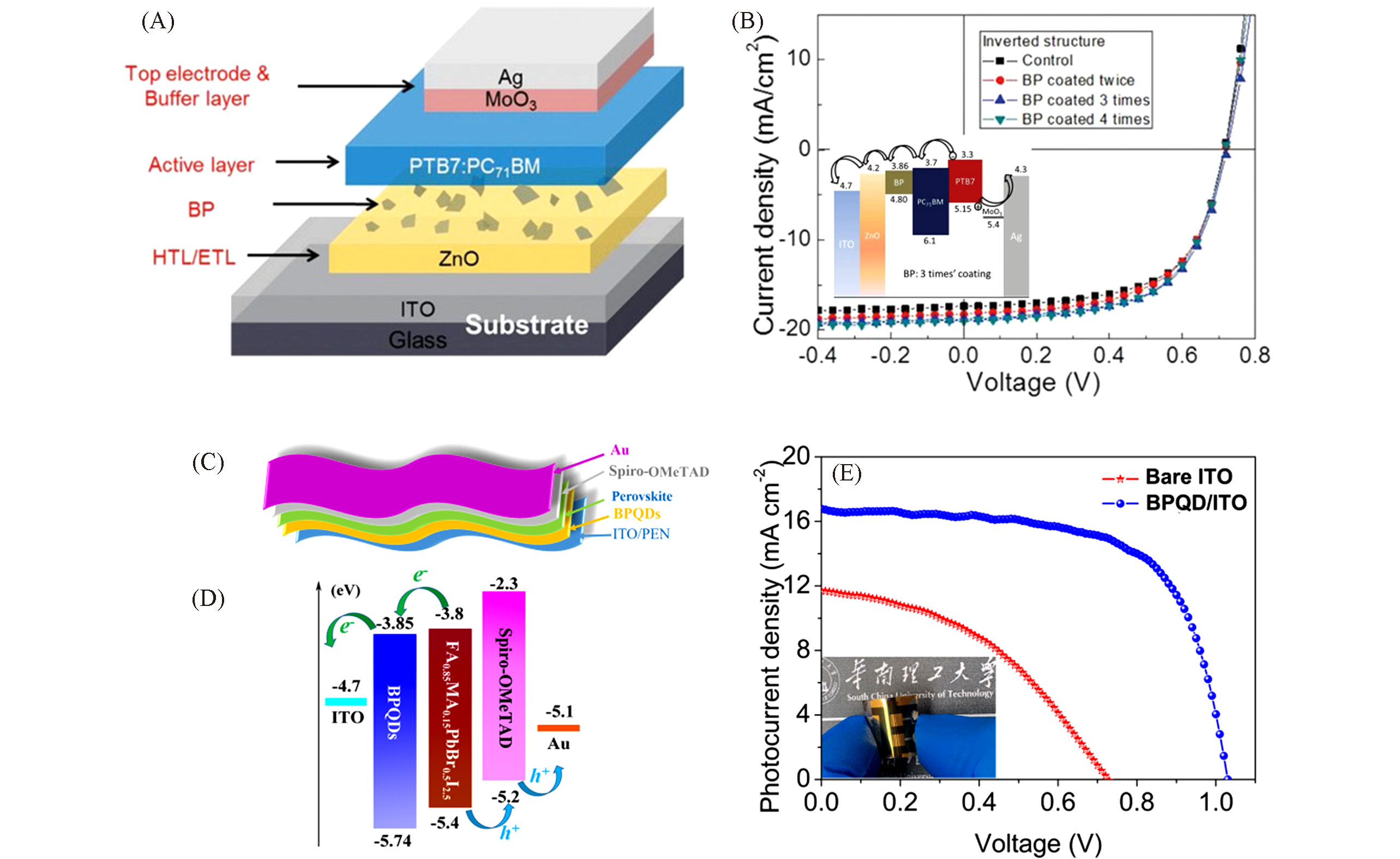
Fig.9 BPQD as electron transport materials for organic solar cell and perovskite solar cell(A) The inverted architectures and of OPVs based on PTB7/PC71BM;(B) J?V characteristics of inverted OPVs with BP incorporation under different conditions(the inset of (B) shows the energy band structure of the OPV based on PTB7/PC71BM with the incorporation of BP, three times coating)[161]. Copyright 2016, WILEY‐VCH Verlag GmbH & Co. KGaA, Weinheim. (C) Schematic illustration of the plastic organic-inorganic perovskite solar cells with BPQDs ETL; (D) energy level diagram of each component of PSCs; (E) J?V characteristic curves of PSCs built on BPQDs electron selective layer(ESL) and bare ITO substrate, measured under 1 sun illumination(100 mW/cm2) in a reverse scan[7]. Copyright 2018, The Royal Society of Chemistry.
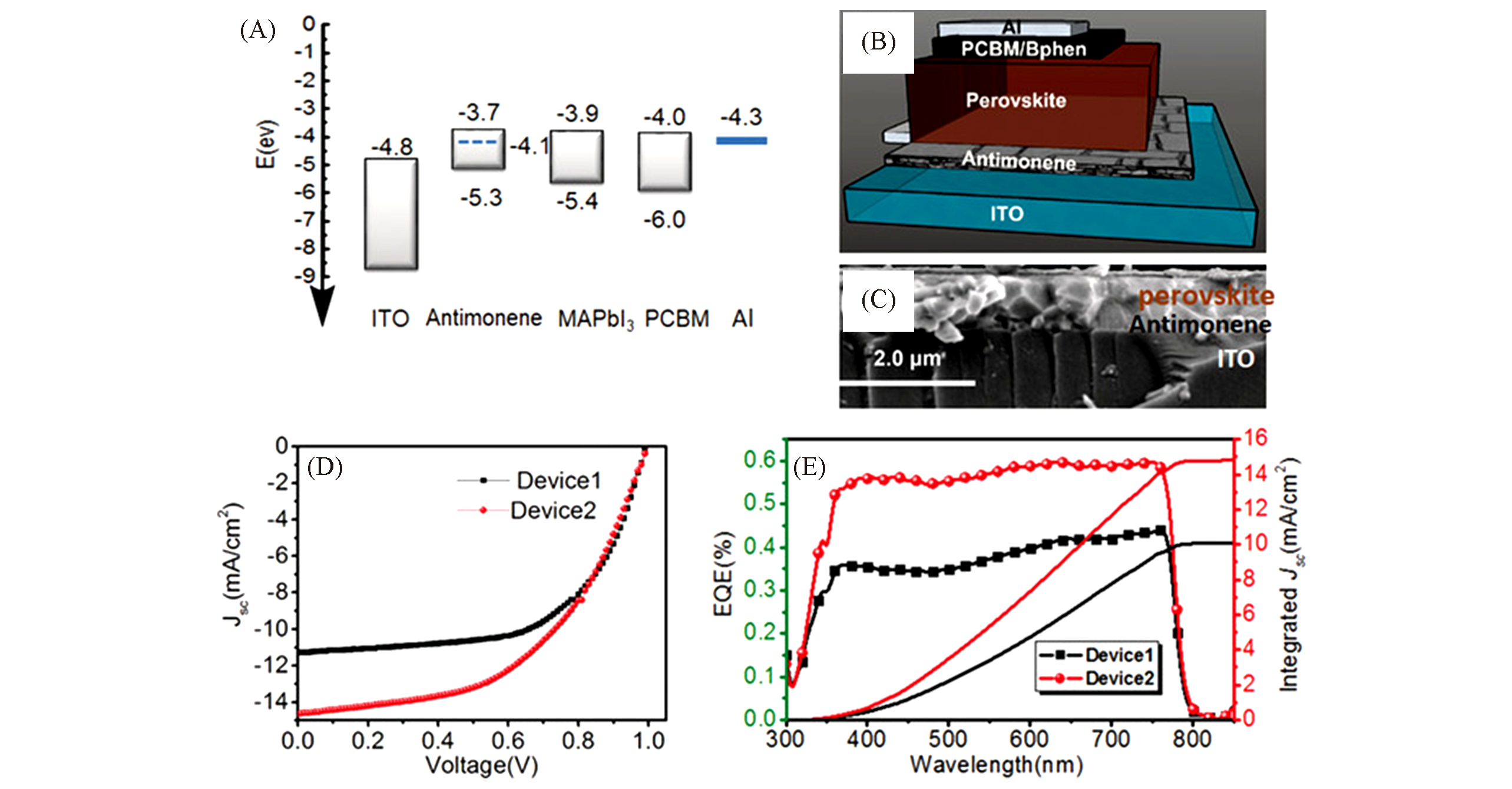
Fig.10 Antimonene as electron transport materials for perovskite solar cells[168](A) The energy levels of each functional layer of PSC with an antimonene HTL; (B) configuration of the antimonene-based device;(C) cross-sectional SEM image of the device; (D, E) J?V curves(D) and external quantum efficiency(EQE) spectra(E) of devices without HTL(Device 1) and with antimonene HTL(Device 2). Copyright 2018, WILEY‐VCH Verlag GmbH & Co. KGaA, Weinheim.
| 1 | Novoselov K. S., Geim A. K., Morozov S. V., Jiang D., Zhang Y., Dubonos S. V., Grigorieva I. V., Firsov A. A., Science, 2004, 306, 666—669 |
| 2 | Mak K.F., Lee C., Hone J., Shan J., Heinz T.F., Phys. Rev. Lett., 2010, 105, 136805 |
| 3 | Georgiou T., Jalil R., Belle B. D., Britnell L., Gorbachev R. V., Morozov S. V., Kim Y., Gholinia A., Haigh S. J., Makarovsky O., Eaves L., Ponomarenko L. A., Geim A. K., Novoselov K. S., Mishchenko A., Nat. Nanotechnol., 2013, 8, 100—103 |
| 4 | Li L., Yang F., Ye G. J., Zhang Z., Zhu Z., Lou W., Zhou X., Li L., Watanabe K., Taniguchi T., Chang K., Wang Y., Chen X. H., Zhang Y., Nat Nanotechnol., 2016, 11, 593 |
| 5 | Liu S., Lin S., You P., Surya C., Lau S., Yan F., Angew. Chem., 2017, 129, 13905—13909 |
| 6 | Lin S., Li Y., Lu W., Chui Y., Rogée L., Bao Q., Lau S., 2D Mater., 2017, 4, 025001 |
| 7 | Fu N., Huang C., Lin P., Zhu M., Li T., Ye M., Lin S., Zhang G., Du J., Liu C., Xu B., Wang D., Ke S., J. Mater. Chem. A, 2018, 6, 8886—8894 |
| 8 | Yuan J., Sun T., Hu Z., Yu W., Ma W., Zhang K., Sun B., Lau S. P., Bao Q., Lin S., Li S., ACS Appl. Mater. Interfaces, 2018, 10, 40614—40622 |
| 9 | Lin S., Liu Y., Hu Z., Lu W., Mak C., Zeng L., Zhao J., Li Y., Yan F., Tsang Y., Zhang X., Lau S., Nano Energy, 2017, 42, 26—33 |
| 10 | Yuan J., Mu H., Li L., Chen Y., Yu W., Zhang K., Sun B., Lin S., Li S., Bao Q., ACS Appl. Mater. Interfaces, 2018, 10, 21534—21540 |
| 11 | Castellanos⁃Gomez A., Nat. Photonics, 2016, 10, 202 |
| 12 | Glavin N. R., Rao R., Varshney V., Bianco E., Apte A., Roy A., Ringe E., Ajayan P. M., Adv. Mater., 2019, 32, 1904302 |
| 13 | Mannix A. J., Kiraly B., Hersam M. C., Guisinger N. P., Nat. Rev. Chem., 2017, 1, 0014 |
| 14 | Zhang Y., Rubio A., Lay G., J. Phys. D: Appl. Phys., 2017, 50, 053004 |
| 15 | Bachra M. E., Zaari H., Benyoussef A., Kenz A. E., Hachimi A. G. E., J. Supercond. Novel Magn., 2018, 31, 2579—2588 |
| 16 | Broek B. V. D., Houssa M., Scalise E., Pourtois G., Afanas’ev V. V., Stesmans A., 2D Mater., 2014, 1, 021004 |
| 17 | Matusalem F., Marques M., Teles L. K., Bechstedt F., Phys. Rev. B, 2015, 92, 045436 |
| 18 | Şahin H. Cahangirov S., Topsakal M., Bekaroglu E., Akturk E., Senger R. T., Ciraci S., Phys. Rev. B, 2009, 80, 155453 |
| 19 | Tang P. Chen P., Cao W., Huang H., Cahangirov S., Xian L., Xu Y., Zhang S. C., Duan W., Rubio A., Phys. Rev. B, 2014, 90, 121408 |
| 20 | Xu Y., Tang P., Zhang S. C., Phys. Rev. B, 2015, 92, 081112 |
| 21 | Takeda K., Shiraishi K., Phys. Rev. B, 1994, 50, 14916 |
| 22 | Cahangirov S., Topsakal M., Aktürk E., Şahin H., Ciraci S., Phys. Rev. Lett., 2009, 102, 236804 |
| 23 | Dávila M. E., Xian L., Cahangirov S., Rubio A., Le Lay G., New J. Phys., 2014, 16, 095002 |
| 24 | Zhu F., Chen W., Xu Y., Gao C. L., Guan D. D., Liu C. H., Qian D., Zhang S. C., Jia J. J., Nat. Mater., 2015, 14, 1020—1025 |
| 25 | Vogt P., Padova P. D., Quaresima C., Avila J., Frantzeskakis E., Asensio M. C., Resta A., Ealet B., Lay G. L., Phys. Rev. Lett., 2012, 108, 155501 |
| 26 | Derivaz M., Dentel D., Stephan R., Hanf M., Mehdaoui A., Sonnet P., Pirri C., Nano Lett., 2015, 15, 2510—2516 |
| 27 | Deng J., Xia B., Ma X., Chen H., Shan H., Zhai X., Li B., Zhao A., Xu Y., Duan W., Zhang S., Wang B., Hou J. G., Nat. Mater., 2018, 17, 1081—1086 |
| 28 | Aufray B., Kara A., Vizzini S., Oughaddou H., Léandri C., Ealet B., Lay G. L., Appl. Phys. Lett., 2010, 96, 183102 |
| 29 | Mannix A. J., Zhou X. F., Kiraly B., Wood J. D., Alducin D., Myers B. D., Liu X., Fisher B. L., Santiago U., Guest J. R., Yacaman M. J., Ponce A., Oganov A. R., Hersam M. C., Guisinger N. P., Science, 2015, 350, 1513—1516 |
| 30 | Lei T., Liu C., Zhao J. L., Li J. M., Li Y. P., Wang J. O., Wu R., Qian H. J., Wang H. Q., Ibrahim K., J. Appl. Phys., 2016, 119, 015302 |
| 31 | Singh D., Gupta S. K., LukacěvićI., Sonvane Y., RSC Adv., 2016, 6, 8006—8014 |
| 32 | Reis F., Li G., Dudy L., Bauernfeind M., Glass S., Hanke W., Thomale R., Schäfer J., Claessen R., Science, 2017, 357, 287—290 |
| 33 | Zhu Z., Cai X., Yi S., Chen J., Dai Y., Niu C., Guo Z., Xie M., Liu F., Cho J. H., Jia Y., Zhang Z., Phys. Rev. Lett., 2017, 119, 106101 |
| 34 | Qin J., Qiu G., Jian J., Zhou H., Yang L., Charnas A., Zemlyanov D. Y., Xu C. Y., Xu X., Wu W., Wang H., Ye P. D., ACS Nano, 2017, 11, 10222—10229 |
| 35 | Kochat V., Samanta A., Zhang Y., Bhowmick S., Manimunda P., Asif S. A. S., Stender A. S., Vajtai R., Singh A. K., Tiwary C. S., Ajayan P. M., Sci. Adv., 2018, 4, e1701373 |
| 36 | Yuhara J., He B., Matsunami N., Nakatake M., Le Lay G., Adv. Mater., 2019, 31, 1901017 |
| 37 | Yeoh K. H. Y., Rusi T. L., Ong D. S., Lim T. L., Appl. Surf. Sci., 2018, 445, 161—166 |
| 38 | Glavin N. R., Rao R., Varshney V., Bianco E., Apte A., Roy A., Ringe E., Ajayan P. M., Adv. Mater., 2019, 32, 1904302 |
| 39 | Huang Y., Shirodkar S. N., Yakobson B. I., J. Am. Chem. Soc., 2017, 139, 17181—17185 |
| 40 | Boustani I., Quandt A., Hernández E., Rubio A., J. Chem. Phys., 1999, 110, 3176 |
| 41 | Tang H., Ismail⁃Beigi S., Phys. Rev. Lett., 2007, 99, 115501 |
| 42 | Wu J., Mao N., Xie L., Xu H., Zhang J., Angew. Chem. Int. Ed., 2015, 54, 2366—2369 |
| 43 | Lam K.T., Dong Z., Guo J., IEEE Electron Device Letters, 2014, 35, 963—965 |
| 44 | Wu X., Shao Y., Liu H., Feng Z., Wang Y. L., Sun J. T., Liu C., Wang J. O., Liu Z. L., Zhu S. Y., Wang Y. Q., Du S. X., Shi Y. G., Ibrahim K., Gao H. J., Adv. Mater., 2017, 29, 1605407 |
| 45 | Wang G., Pandey R., Karna S. P., ACS Appl. Mater. Interfaces, 2015, 7, 11490—11496 |
| 46 | Aktürk E., Aktürk U. O., Ciraci S., Phys. Rev. B, 2016, 94, 014115 |
| 47 | Lu Y., Xu W., Zeng M., Yao G., Shen L., Yang M., Luo Z., Pan F., Wu K., Das T., He P., Jiang J., Martin J., Feng Y. P., Lin H., Wang X. S., Nano Lett., 2015, 15, 80—87 |
| 48 | Li X., Tao L., Chen Z., Fang H., Li X., Wang X., Xu J., Zhu H., Appl. Phys. Rev., 2017, 4, 021306 |
| 49 | Lin S., Chui Y., Li Y., Lau S., FlatChem, 2017, 2, 15—37 |
| 50 | Hernandez Y., Nicolosi V., Lotya M., Blighe F. M., Sun Z., De S., McGovern I. T., Holland B., Byrne M., Gun’Ko Y. K., Boland J. J., Niraj P., Duesberg G., Krishnamurthy S., Goodhue R., Hutchison J., Scardaci V., Ferrari A. C., Coleman J. N., Nat. Nanotechnol., 2008, 3, 563—568 |
| 51 | Gu W., Zhang W., Li X., Zhu H., Wei J., Li Z., Shu Q., Wang C., Wang K., Shen W., Kang F., Wu D., J. Mater. Chem., 2009, 19, 3367—3369 |
| 52 | Zeng Z., Yin Z., Huang X., Li H., He Q., Lu G., Boey F., Zhang H., Angew. Chem., Int. Ed., 2011, 50, 11093—11097 |
| 53 | Coleman J. N., Lotya M., O’Neill A., Bergin S. D., King P. J., Khan U., Young K., Gaucher A., De S., Smith R. J., Shvets I. V., Arora S. K., Stanton G., Kim H. Y., Lee K., Kim G. T., Duesberg G. S., Hallam T., Boland J. J., Wang J. J., Donegan J. F., Grunlan J. C., Moriarty G., Shmeliov A., Nicholls R. J., Perkins J. M., Grieveson E. M., Theuwissen K., McComb D. W., Nellist P. D., Nicolosi V., Science, 2011, 331, 568—571 |
| 54 | Zheng J., Zhang H., Dong S., Liu Y., Nai C. T., Shin H. S., Jeong H. Y., Liu B., Loh K. P., Nat. Commun., 2014, 5, 2995 |
| 55 | Li X., Cai W., An J., Kim S., Nah J., Yang D., Piner R., Velamakanni A., Jung I., Tutuc E., Banerjee S. K., Colombo L., Ruoff R. S., Science, 2009, 324, 1312—1314 |
| 56 | Bae S., Kim H., Lee Y., Xu X., Park J., Zheng Y., Balakrishnan J., Lei T., Kim H. R., Song Y., Kim Y., Kim K. S., Ozyilmaz B., Ahn J., Hong B. H., Iijima S., Nat. Nanotechnol., 2010, 5, 574—578 |
| 57 | Reina A., Jia X., Ho J., Nezich D., Son H., Bulovic V., Dresselhaus M. S., Kong J., Nano Lett., 2009, 9, 30—35 |
| 58 | Kim K. S., Zhao Y., Jang H., Lee S. Y., Kim J. M., Kim K. S., Ahn J. H., Kim P., Choi J., Hong B. H., Nature, 2009, 457, 706—710 |
| 59 | Sun Z., Yan Z., Yao J., Beitler E., Zhu Y., Tour J. M., Nature, 2010, 468, 549—552 |
| 60 | Li Z., Wu P., Wang C., Fan X., Zhang W., Zhai X., Zeng C., Li Z., Yang J., Hou J., ACS Nano, 2011, 5, 3385—3390 |
| 61 | Wan X., Chen K., Liu D., Chen J., Miao Q., Xu J., Chem. Mater., 2012, 24, 3906—3915 |
| 62 | Li X., Cai W., Colombo L., Ruoff R. S., Nano Lett., 2009, 9, 4268—4272 |
| 63 | Song L., Ci L., Lu H., Sorokin P. B., Jin C., Ni J., Kvashnin A. G., Kvashnin D. G., Lou J., Yakobson B. I., Ajayan P. M., Nano Lett., 2010, 10, 3209—3215 |
| 64 | Kim K. K., Hsu A., Jia X., Kim S. M., Shi Y., Hofmann M., Nezich D., Rodriguez⁃Nieva J. F., Dresselhaus M., Palacios T., Kong J., Nano Lett., 2012, 12, 161—166 |
| 65 | Guo N., Wei J., Jia Y., Sun H., Wang Y., Zhao K., Shi X., Zhang L., Li X., Cao A., Zhu H., Wang K., Wu D., Nano Res., 2013, 6, 602—610 |
| 66 | Kim S. M., Hsu A., Park M. H., Chae S. H., Yun S. J., Lee J. S., Cho D., Fang W., Lee C., Palacios T., Dresselhaus M., Kim K. K., Lee Y. H., Kong J., Nat. Commun., 2015, 6, 8662 |
| 67 | Lee Y. H., Zhang X. Q., Zhang W., Chang M. T., Lin C., Chang K., Yu Y., Wang J. T. W., Chang C., Li L., Lin T., Adv. Mater., 2012, 24, 2320—2325 |
| 68 | Najmaei S., Liu Z., Zhou W., Zou X., Shi G., Lei S., Yakobson B. I., Idrobo J., Ajayan P. M., Lou J., Nat. Mater., 2013, 12, 754—759 |
| 69 | van der Zande A. M., Huang P. Y., Chenet D. A., Berkelbach T. C., You Y., Lee G., Heinz T. F., Reichman D. R., Muller D. A., Hone J. C., Nat. Mater., 2013, 12, 554—561 |
| 70 | Kiraly B., Liu X., Wang L., Zhang Z., Mannix A. J., Fisher B. L., Yakobson B. I., Hersam M. C., Guisinger N. P., ACS Nano, 2019, 13, 3816—3822 |
| 71 | Liu K., Zhang W., Lee Y., Lin Y., Chang M., Su C., Chang C., Li H., Shi Y., Zhang H., Lai C., Li L., Nano Lett., 2012, 12, 1538—1544 |
| 72 | Pirkle A., Chan J., Venugopal A., Hinojos D., Magnuson C. W., McDonnell S., Colombo L., Vogel E. M., Ruoff R. S., Wallace R. M., Appl. Phys. Lett., 2011, 99, 122108 |
| 73 | Lock E. H., Baraket M., Laskoski M., Mulvaney S. P., Lee W. K., Sheehan P. E., Hines D. R., Robinson J. T., Tosado J., Fuhrer M. S., Hernandez S. C., Walton S. G., Nano Lett., 2012, 12, 102—107 |
| 74 | Zhang P., Ma L., Fan F., Zeng Z., Peng C., Loya P. E., Liu Z., Gong Y., Zhang J., Zhang X., Ajayan P. M., Zhu T., Lou J., Nat. Commun., 2014, 5, 3782 |
| 75 | Castellanos⁃Gomez A., Buscema M., Molenaar R., Singh V., Janssen L., van der Zant H. S. J., Steele G. A., 2D Mater., 2014, 1, 011002 |
| 76 | Mainville M., Leclerc M., ACS Energy Lett.,2020, 5, 1186—1197 |
| 77 | Yao H., Wang J., Xu Y., Zhang S., Hou J., Acc. Chem. Res., 2020, 53, 822—832 |
| 78 | Rasi D. D. C., Janssen R. A. J., Adv. Mater.,2019, 31, 1806499 |
| 79 | Lu L., Zheng T., Wu Q., Schneider A. M., Zhao D., Yu L., Chem. Rev., 2015, 115, 12666—12731 |
| 80 | Wang J., Liu K., Ma L., Zhan X., Chem. Rev., 2016, 116, 14675—14725 |
| 81 | Galagan Y., J. Phys. Chem. Lett., 2018, 9, 4326—4335 |
| 82 | Fu N., Zhi Y. B., Zhang Y. L., Zhang G., Ke S., Lin P., Dai J., Huang H., Lei D., Nano Energy, 2017, 41, 654—664 |
| 83 | Tress W., Domanski K., Carlsen B., Agarwalla A., Alharbi E. A., Graetzel M., Hagfeldt A., Nat. Energy, 2019, 4, 568—574 |
| 84 | Park N. G., Zhu K., Nat. Rev. Mater., 2020, 5, 333—350 |
| 85 | Huang C., Lin P., Fu N., Liu C., Xu B., Sun K., Wang D., Zeng X., Ke S., Chem. Commun., 2019, 55, 2777—2780 |
| 86 | NREL Chart: Best Research⁃Cell Efficiencies, https://www.nrel.gov/pv/cell⁃efficiency.html(accessed: 2019) |
| 87 | Hou Y., Quiroz C. O. R., Scheiner S., Chen W., Stubhan T., Hirsch A., Halik M., Brabec C. J., Adv. Energy Mater., 2015, 5, 1501056 |
| 88 | Malinkiewicz O., Yella A., Lee Y. H., Espallargas G. M., Gräetzel M., Nazeeruddin M. K., Bolink H. J., Nat. Photonics,2014, 8, 128—132 |
| 89 | Chen S., Shi G., Adv. Mater., 2017, 29, 1605448 |
| 90 | Balis N., Stratakis E., Kymakis E., Mater. Today, 2016, 19, 580—594 |
| 91 | Bati A. S. R., Batmunkh M., Shapter J. G., Adv. Energy Mater., 2020, 10, 1902253 |
| 92 | Wang B., Iocozzia J., Zhang M., Ye M., Yan S., Jin H., Wang S., Zou Z., Lin Z., Chem. Soc. Rev., 2019, 48, 4854—4891 |
| 93 | Das S., Pandey D., Thomas J., Roy T., Adv. Mater., 2019, 31, 1802722 |
| 94 | Chang D. W., Choi H. J., Filer A., Baek J. B., J. Mater. Chem. A, 2014, 2, 12136—12149 |
| 95 | Geim A. K., Science,2009, 324, 1530—1534 |
| 96 | Geim A. K., Novoselov K. S., Nat. Mater.,2007, 6, 183—191 |
| 97 | Miro P., Audiffred M., Heine T., Chem. Soc. Rev., 2014, 43, 6537—6554 |
| 98 | Schwierz F., Nat. Nanotechnol., 2010, 5, 487—496 |
| 99 | Dai L., Acc. Chem. Res., 2013, 46, 31—42 |
| 100 | Wu Z. S., Ren W., Xu L., Li F., Cheng H. M., ACS Nano, 2011, 5, 5463—5471 |
| 101 | Capasso A., Salamandra L., Faggio G., Dikonimos T., Buonocore F., Morandi V., Ortolani L., Lisi N., ACS Appl. Mater. Interfaces, 2016, 8, 23844—23853 |
| 102 | Bonaccorso F., Balis N., Stylianakis M. M., Savarese M., Adamo C., Gemmi M., Pellegrini V., Stratakis E., Kymakis E., Adv. Funct. Mater., 2015, 25, 3870—3880 |
| 103 | Li Z., Wang Y., Kozbial A., Shenoy G., Zhou F., McGinley R., Ireland P., Morganstein B., Kunkel A., Surwade S. P., Li L., Liu H., Nat. Mater., 2013, 12, 925—931 |
| 104 | Jung S., Lee J., Choi Y., Lee S. M., Yang C., Park H., 2D Mater., 2017, 4, 045004 |
| 105 | Liu Z., You P., Liu S., Yan F., ACS Nano, 2015, 9, 12026—12034 |
| 106 | Mahmoudi T., Wang Y., Hahn Y. B., Nano Energy, 2018, 47, 51—65 |
| 107 | Dreyer D. R., Park S. J., Bielawski C. W., Ruoff R. S., Chem. Soc. Rev., 2010, 39, 228—240 |
| 108 | Boucléa J., Herlin⁃Boime N., Synthetic Met., 2016, 222, 3—16 |
| 109 | Yang D., Zhou L., Chen L., Zhao B., Zhang J., Li C., Chem. Commun., 2012, 48, 8078—8080 |
| 110 | Loh K. P., Bao Q., Eda G., Chhowalla M., Nat. Chem., 2010, 2, 1015—1024 |
| 111 | Li S. S., Tu K. H., Lin C. C., Chen C. W., Chhowalla M., ACS Nano, 2010, 4, 3169—3174 |
| 112 | Smith C. T. G., Rhodes R. W., Beliatis M. J., Jayawardena K. D. G. I., Rozanski L. J., Mills C. A., Silva S. R. P., Appl. Phys. Lett., 2014, 105, 073304 |
| 113 | Wang D. H., Kim J. K., Seo J. H., Park I., Hong B. H., Park J. H., Heeger A. J., Angew. Chem. Int. Ed., 2013, 52, 2874—2880 |
| 114 | Yan K., Wei Z., Li J., Chen H., Yi Y., Zheng X., Long X., Wang Z., Wang J., Xu J., Yang S., Small, 2015, 11, 2269—2274 |
| 115 | Yang Q. D., Li J., Cheng Y., Li H. W., Guan Z., Yu B., Tsang S. W., J. Mater. Chem. A, 2017, 5, 9852—9858 |
| 116 | Le Q. V., Choi J. Y., Kim S. Y., FlatChem, 2017, 2, 54—66 |
| 117 | Zibouche N., Volonakis G., Giustin F., J. Phys. Chem. C, 2018, 122, 16715—16726 |
| 118 | Li C., Yang X., Zhao Y., Zhang P., Tu Y., Li Y., Org. Electron., 2014, 15, 2868—2875 |
| 119 | Eda G., Mattevi C., Yamaguchi H., Kim H., Chhowalla M., J. Phys. Chem. C,2009, 113, 15768—15771 |
| 120 | Eda G., Fanchini, G., Chhowalla M., Nat. Nanotechnol.,2008, 3, 270—274 |
| 121 | Liu X., Kim H., Guo L. J., Org. Electron., 2013, 14, 591—598 |
| 122 | Liu Z., Liu L., Li H., Dong Q., Yao S., Kidd IV A. B., Zhang X., Li J., Tia W., Solar Energy Mater. Solar Cells, 2012, 97, 28—33 |
| 123 | Yun J. M., Yeo J. S., Kim J., Jeong H. G., Kim D. Y., Noh Y. J., Kim S. S., Ku B. C., Na S. I., Adv. Mater., 2011, 23, 4923—4928 |
| 124 | Palma A. L., Cinà L., Pescetelli S., Agresti A., Raggio M., Paolesse R., Bonaccorso F., Carlo A. D., Nano Energy, 2016, 22, 349—360 |
| 125 | Yin X., Zhou Y., Han J., Nan H., Tai M., Gu Y., Li J., Lin H., J. Mater. Chem. A, 2018, 6, 20702—20711 |
| 126 | Han G. S., Song Y. H., Jin Y. U., Lee J. W., Park N. G., Kang B. K., Lee J. K., Cho I. S., Yoon D. Ho., Jung H. S., ACS Appl. Mater. Interfaces, 2015, 7, 23521—23526 |
| 127 | Jun G. H., Jin S. H., Lee B., Kim B. H., Chae W. S., Hong S. H., Jeon S., Energy Environ. Sci., 2013, 6, 3000—3006 |
| 128 | Jung S., Lee J., Seo J., Kim U., Choi Y., Park H., Nano Lett., 2018, 18, 1337—1343 |
| 129 | Zhu Y., Jia S., Zheng J., Lin Y., Wu Y., Wang J., J. Mater. Chem. C, 2018, 6, 3097—3103 |
| 130 | Konios D., Kakavelakis G., Petridis C., Savva K., Stratakisa E., Kymakis E., J. Mater. Chem. A, 2016, 4, 1612—1623 |
| 131 | Agresti A., Pescetelli S., Cinà L., Konios D., Kakavelakis G., Kymakis E., Carlo A. D., Adv. Funct. Mater.,2016, 26, 2686—2694 |
| 132 | Li X., Xie D., Park H., Zhu M., Zeng T. H., Wang K., Wei J., Wu D., Kong J., Zhu H., Nanoscale, 2013, 5, 1945—1948 |
| 133 | Pan F., Sun C., Li Y., Tang D., Zou Y., Li X., Bai S., Wei X., Lv M., Chen X., Li Y., Energy Environ. Sci., 2019, 12, 3400—3411 |
| 134 | Kasry A., Kuroda M. A., Martyna G. J., Tulevski G. S, Bol A. A., ACS Nano, 2010, 4, 3839—3844 |
| 135 | Bae S., Kim H., Lee Y., Xu X. F., Park J. S., Zheng Y., Balakrishnan J., Lei T., Kim H. R., Song Y. I., Kim Y. J., Kim K. S., Ozyilmaz B., Ahn J. H., Hong B. H., Iijima S., Nat. Nanotechnol., 2010, 5, 574—578 |
| 136 | Shi Y. M., Kim K. K., Reina A., Hofmann M., Li L. J., Kong J., ACS Nano, 2010, 4, 2689—2694 |
| 137 | Tung V. C., Chen L. M., Allen M. J., Wassei J. K., Nelson K., Kaner R. B., Yang Y., Nano Lett., 2009, 9, 1949—1955 |
| 138 | Liu Z., Liu L., Li H., Dong Q., Yao S., Kidd IV A. B., Zhang X, Li J., Tian W., Solar Energy Mater. Solar Cells, 2012, 97, 28—33 |
| 139 | Cao J., Liu Y. M., Jing X., Yin J., Li J., Xu B., Tan Y. Z., Zheng N., J. Am. Chem. Soc., 2015, 137, 10914—10917 |
| 140 | Yeo J. S., Kang R., Lee S., Jeon Y. J., Myoung N., Lee C. L., Kim D. Y., Yun J. M., Seo Y. H., Kim S. S., Na S. I., Nano Energy, 2015, 12, 96—104 |
| 141 | Beliatis M. J., Gandhi K. K., Rozanski L. J., Rhodes R., McCafferty L., Alenezi M. R., Alshammari A. S., Mills A., Jayawardena K. D. G. I., Henley J., Silva S. R. P., Adv. Mater., 2014, 26, 2078—2083 |
| 142 | Mann D. S., Seo Y. H., Kwon S. N., Na S. I., J. Alloys Comd., 2020, 812, 152091 |
| 143 | Agresti A., Pescetelli S., Palma A. L., Castillo A. E. D. R., Konios D., Kakavelakis G., Razza S., Cina L., Kymakis E., Bonaccorso F., Carlo A. D., ACS Energy Lett., 2017, 2, 279—287 |
| 144 | Zhao X., Tao L., Li H., Huang W., Sun P., Liu J., Liu S., Sun Q., Cui Z., Sun L., Shen Y., Yang Y., Wang M., Nano Lett., 2018, 18, 2442—2449 |
| 145 | Meng X., Cui X., Rager M., Zhang S., Wang Z., Yu J., Harn Y. W., Kang Z., Wagner B. K., Liu Yang., Yu C., Qiu J., Lin Z., Nano Energy, 2018, 52, 123—133 |
| 146 | Li W., Dong H., Guo X., Li N., Li J., Niu G., Wang L., J. Mater. Chem. A, 2014, 2, 20105—20111 |
| 147 | Jo S. B., Kim H. H., Lee H., Kang B., Lee S., Sim M., Kim M., Lee W. H., Cho K., ACS Nano, 2015, 9, 8206—8219 |
| 148 | Gui R., Jin H., Wang Z., Li J., Chem. Soc. Rev., 2018, 47, 6795—6823 |
| 149 | Pang J., Bachmatiuk A., Yin Y., Trzebicka B., Zhao L., Fu L., Mendes R. G., Gemming T., Liu Z., Rummeli M. H., Adv. Energy Mater., 2018, 8, 1702093 |
| 150 | Zhao Y., Chen Y., Zhang Y. H., Liu S. F., Mater. Chem. Phys., 2017, 189, 215—229 |
| 151 | Qiao J., Kong X., Hu Z. X., Yang F., Ji W., Nat. Commun., 2014, 5, 4475 |
| 152 | Ding K. N., Wen L. L., Huang S. P., Li Y. L., Zhang Y. F., Lu Y. P., RSC Adv., 2016, 6, 80872—80884 |
| 153 | Liu H., Du Y., Deng Y., Ye P. D., Chem. Soc. Rev., 2015, 44, 2732—2743 |
| 154 | Yang Z., Hao J., Small Methods, 2018, 2, 1700296 |
| 155 | Batmunkh M., Bat⁃Erdene M., Shapter J. G., Adv. Energy Mater., 2018, 8, 1701832 |
| 156 | Makha M., Ghailane A., Larhlimi H., Alami J.,Mater. Lett., 2020, 276, 128234 |
| 157 | Wiktor J., Pasquarello A., Phys. Rev. B, 2016, 94, 245411 |
| 158 | Chen W., Li K., Wang Y., Feng X., Liao Z., Su Q., Lin X., He Z., J. Phys. Chem. Lett., 2017, 8, 591—598 |
| 159 | Muduli S. K., Varrla E., Kulkarni S. A., Han G., Thirumal K., Lev O., Mhaisalkar S., Mathews N., J. Power Sources, 2017, 371, 156—161 |
| 160 | Zhao Y., Chen T. L., Xiao L., Kolaczkowski M. A., Zhang L., Klivansky L. M., Alto V., Tian B., Guo J., Peng X., Tian Y., Liu Y., Nano Energy, 2018, 53, 345—353 |
| 161 | Lin S., Liu S., Yang Z., Li Y., Ng T. W., Xu Z., Bao Q., Hao J., Lee C. S., Surya C., Yan F., Lau S. P., Adv. Funct. Mater., 2016, 26, 864—871 |
| 162 | Batmunkh M., Vimalanathan K., Wu C., Bati A. S. R., Yu L., Tawfik S. A., Ford M. J., Macdonald T. J., Raston C. L., Priya S., Gibson C. T., Shapter J. G., Small Methods, 2019, 3, 1800521 |
| 163 | Zhang M., Ye M., Wang W., Ma C., Wang S., Liu Q., Lian T., Huang J., Lin Z., Adv. Mater., 2020, 32, 2000999 |
| 164 | Wang Y., Li J., Li T., Wang J., Liu K., Jiang Q., Tang J., Zhan X., Small, 2019, 15, 1903977 |
| 165 | Zhang S., Zhou W., Ma Y., Ji J., Cai B., Yang S. A., Zhu Z., Chen Z., Zeng H., Nano Lett., 2017, 17, 3434—3440 |
| 166 | Wang X., Song J., Qu J., Angew. Chem. Int. Ed., 2019, 58, 1574—1584 |
| 167 | Zhang S., Yan Z., Li Y., Chen Z., Zeng H., Angew. Chem. Int. Ed., 2015, 54, 3112—3115 |
| 168 | Wang X., He J., Zhou B., Zhang Y., Wu J., Hu R., Liu L., Song J., Qu J., Angew. Chem. Int. Ed., 2018, 57, 8668—8673 |
| 169 | Zhang F., He J., Xiang Y., Zheng Y., Xue B., Ye S., Peng X., Hao Y., Lian J., Zeng P., Qu J., Song J., Adv. Mater., 2018, 30, 1803244 |
| 170 | He J., Zhang F., Xiang Y., Lian J., Wang X., Zhang Y., Peng X., Zeng P., Qu J., Song J., J. Power Sources, 2019, 435, 226819 |
| 171 | Wang Z., Wang Z., Wang X., Zhao M., Zhou Y., Zhao B., Miao Y., Liu P., Hao Y., Wang H., Xu B., Wu Y., Yin S., 2D Mater., 2019, 6, 045017 |
| 172 | Wang Z., Zhang R., Zhao M., Wang Z., Wei B., Zhang X., Feng S., Cao H., Liu P., Hao Y., Wang H., Xu B., Pennycookc S. J., Guo J., J. Mater. Chem. A, 2018, 6, 23773—23779 |
| 173 | Pumera M., Sofer Z., Adv. Mater., 2017, 29, 1605299 |
| 174 | Zhang S., Xie M., Li F., Yan Z., Li Y., Kan E., Liu W., Chen Z., Zeng H., Angew. Chem. Int. Ed., 2016, 55, 1666—1669 |
| 175 | Guo Y., Pan F., Ye M., Sun X., Wang Y., Li J., Zhang X., Zhang H., Pan Y., Song Z., Yang J., Lu J., ACS Appl. Mater. Interfaces, 2017, 9, 23128—23140 |
| 176 | Wang Y., Chen K., Hao H., Yu G., Zeng B., Wang H., Zhang F., Wu L., Li J., Xiao S., He J., Zhang Y., Zhang H., Nanoscale, 2019, 11, 2637—2643 |
| 177 | Xue R., Zhou X., Peng S., Xu P., Wang S., Xu C., Zeng W., Xiong Y., Liang D., ACS Sustainable Chem. Eng., 2020, 8, 10714—10725 |
| [1] | ZHOU Yonghui, HUANG Rujun, YAN Jianyang, LI Yajun, QIU Huanhuan, YANG Jinxuan, ZHENG Youxuan. Synthesis and Electroluminescence Properties of Two Iridium(Ⅲ) Complexes with Nitrogen Heterocycle Structures [J]. Chem. J. Chinese Universities, 2022, 43(1): 20210415. |
| [2] | GAO Xiaole, WANG Jiaxin, LI Zhifang, LI Yanchun, YANG Donghua. Synthesis of NiOx-ZSM-5 Composite Materials and Its Electrocatalytic Hydrogen Evolution Performance in Microbial Electrolysis Cell [J]. Chem. J. Chinese Universities, 2021, 42(9): 2886. |
| [3] | LI Huiyang, ZHU Siying, LI Sha, ZHANG Qiaobao, ZHAO Jinbao, ZHANG Li. Influencing Factors and Promotion Strategies of the First-cycle Coulombic Efficiency of Silicon Suboxide Anodes in Lithium-ion Batteries [J]. Chem. J. Chinese Universities, 2021, 42(8): 2342. |
| [4] | SU Yingli, REN Haisheng, LI Xiangyuan. Application of New Nonequilibrium Solvation Theory in Electronic Spectra of Organic Dyes [J]. Chem. J. Chinese Universities, 2021, 42(7): 2254. |
| [5] | YUE Shengli, WU Guangbao, LI Xing, LI Kang, HUANG Gaosheng, TANG Yi, ZHOU Huiqiong. Research Progress of Quasi-two-dimensional Perovskite Solar Cells [J]. Chem. J. Chinese Universities, 2021, 42(6): 1648. |
| [6] | WANG Kunhua, YAO Jisong, YANG Junnan, SONG Yonghui, LIU Yuying, YAO Hongbin. Synthesis and Device Optimization of Highly Efficient Metal Halide Perovskite Light-emitting Diodes [J]. Chem. J. Chinese Universities, 2021, 42(5): 1464. |
| [7] | LI Shiheng, WANG Chao, LU Zhenda. Challenges and Recent Progress of Prelithiation for Si-Based Anodes in Lithium-ion Batteries [J]. Chem. J. Chinese Universities, 2021, 42(5): 1530. |
| [8] | WU Tao,MU Xiaoqing,NIE Yao,XU Yan. Improving Catalytic Efficiency of Bacillus Cereus Amine Dehydrogenase for Acetophenone Reduction by Iterative Saturation Mutagenesis † [J]. Chem. J. Chinese Universities, 2020, 41(5): 1018. |
| [9] | JIANG Yefang, DONG Ru, CAI Xuediao, FENG Jiangshan, LIU Zhike, LIU Shengzhong. Effect of Amphiphilic Quaternary Ammonium Salt Additive on Performance and Stability of Perovskite Solar Cells [J]. Chem. J. Chinese Universities, 2019, 40(8): 1697. |
| [10] | SONG Xipeng, LIU Jinyu, WANG Lihua, HAN Xutong, HUANG Qinglin. Preparation of Polybenzimidazole/Polyvinylpyrrolidone Proton Exchange Membranes for Vanadium Redox Flow Battery† [J]. Chem. J. Chinese Universities, 2019, 40(7): 1543. |
| [11] | ZHANG Kejie,LI Yu,XIA Yuan,HAN Shuo,CAO Jing,WANG Hanyang,LUO Wentao,ZHOU Zhiping. Synthesis and Photocatalytic Performance of CdS/CuS Core-shell Nanocomposites† [J]. Chem. J. Chinese Universities, 2019, 40(3): 489. |
| [12] | QI Juanjuan,DONG Chao,Getinet Y. Ashebir,CHEN Junwei,WAN Zhiyang,CHEN Wangwei,ZHAO Qiuyuan,WANG Mingtai. Effects of Annealing Atmosphere on Composition, Structure and Photovoltaic Properties of Solution-processed Sb2S3 Thin Films† [J]. Chem. J. Chinese Universities, 2019, 40(2): 342. |
| [13] | WU Zhiqiang, LIU Wanyi, WANG Gang, CAI Wei, YUE Xiaofei, ZHAN Haijuan, BI Shuxian, MENG Zhe, MA Baojun. Preparation of Protonated g-C3N4/β-SiC Composites and Photocatalytic Degradation of Alizarin Red S † [J]. Chem. J. Chinese Universities, 2019, 40(10): 2178. |
| [14] | WU Dan, LI Man, ZHONG Yao, AN Kuisheng, CHEN Yanwei. Property of Au Nanoshuttles with Arrow-head Prepared via Wet Chemical Synthetic Method† [J]. Chem. J. Chinese Universities, 2018, 39(8): 1617. |
| [15] | XUE Yun, CAO Meng, YANG Xue, XU Yanlu, YAN Yongde, JI Debin, MA Fuqiu. Electrochemical Extraction of La and Zn-La Alloy Codeposition in Chloride System† [J]. Chem. J. Chinese Universities, 2018, 39(6): 1145. |
| Viewed | ||||||
|
Full text |
|
|||||
|
Abstract |
|
|||||